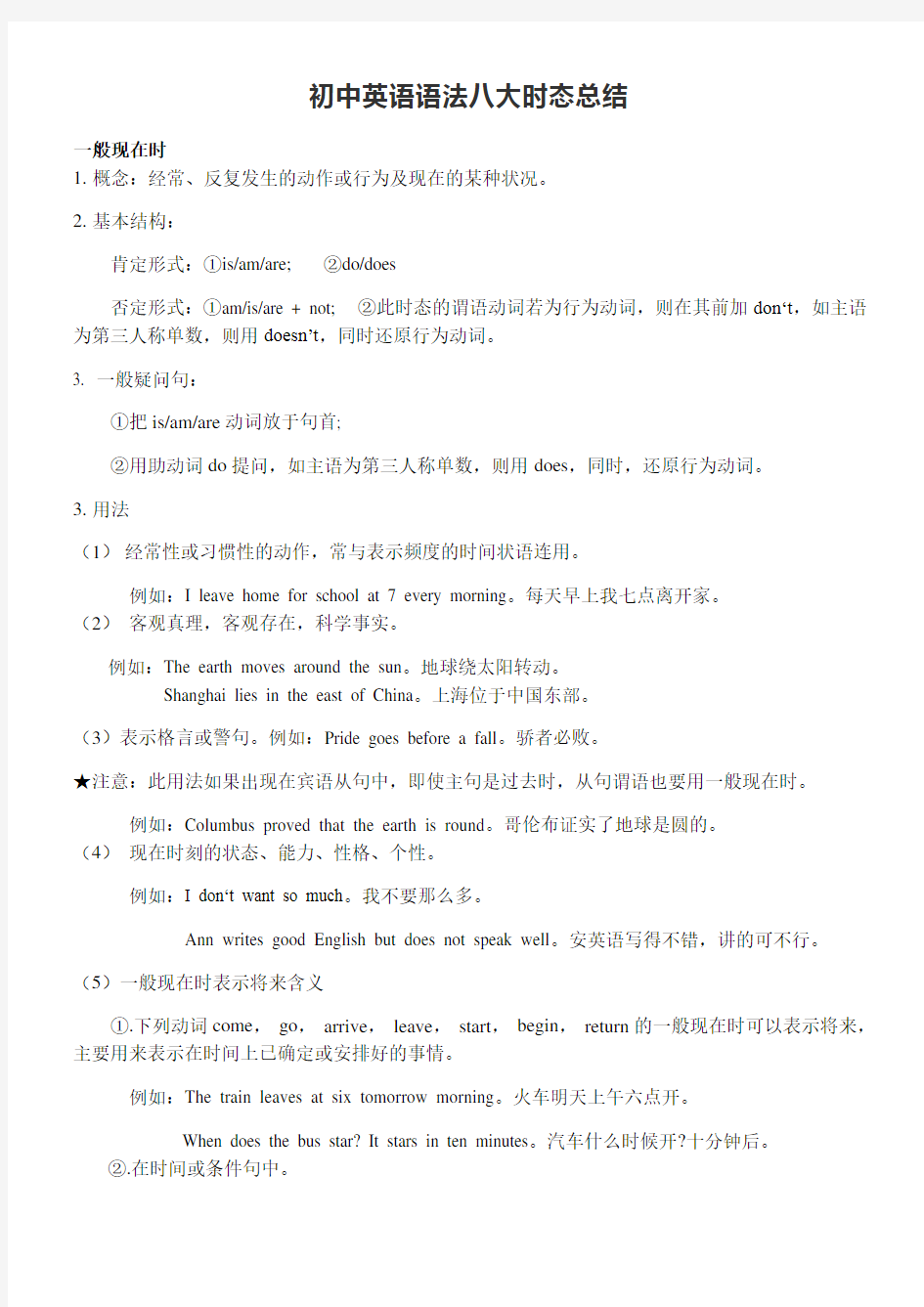初中英语语法八大时态总结

- 1、下载文档前请自行甄别文档内容的完整性,平台不提供额外的编辑、内容补充、找答案等附加服务。
- 2、"仅部分预览"的文档,不可在线预览部分如存在完整性等问题,可反馈申请退款(可完整预览的文档不适用该条件!)。
- 3、如文档侵犯您的权益,请联系客服反馈,我们会尽快为您处理(人工客服工作时间:9:00-18:30)。
初中英语语法八大时态总结
一般现在时
1.概念:经常、反复发生的动作或行为及现在的某种状况。
2.基本结构:
肯定形式:①is/am/are; ②do/does
否定形式:①am/is/are + not; ②此时态的谓语动词若为行为动词,则在其前加don‘t,如主语为第三人称单数,则用doesn’t,同时还原行为动词。
3. 一般疑问句:
①把is/am/are动词放于句首;
②用助动词do提问,如主语为第三人称单数,则用does,同时,还原行为动词。
3.用法
(1)经常性或习惯性的动作,常与表示频度的时间状语连用。
例如:I leave home for school at 7 every morning。每天早上我七点离开家。
(2)客观真理,客观存在,科学事实。
例如:The earth moves around the sun。地球绕太阳转动。
Shanghai lies in the east of China。上海位于中国东部。
(3)表示格言或警句。例如:Pride goes before a fall。骄者必败。
★注意:此用法如果出现在宾语从句中,即使主句是过去时,从句谓语也要用一般现在时。
例如:Columbus proved that the earth is round。哥伦布证实了地球是圆的。
(4)现在时刻的状态、能力、性格、个性。
例如:I don‘t want so much。我不要那么多。
Ann writes good English but does not speak well。安英语写得不错,讲的可不行。
(5)一般现在时表示将来含义
①.下列动词come,go,arrive,leave,start,begin,return的一般现在时可以表示将来,主要用来表示在时间上已确定或安排好的事情。
例如:The train leaves at six tomorrow morning。火车明天上午六点开。
When does the bus star? It stars in ten minutes。汽车什么时候开?十分钟后。
②.在时间或条件句中。
例如:When Bill comes (不是will come),ask him to wait for me。比尔来后,让他等我。
I’ll write to you as soon as I arrive th ere。我到了那里,就写信给你。
一般过去时
1.概念:过去某个时间里发生的动作或状态;过去习惯性、经常性的动作、行为。
2.基本结构:①was/were;②行为动词过去式
否定形式:①was/were + not;②在行为动词前加didn‘t,同时还原行为动词。
一般疑问句:①was或were放于句首;②用助动词do的过去式did 提问,同时还原行为动词。
2.用法
3.用法
(1)在确定的过去时间里所发生的动作或存在的状态。时间状语有:yesterday,last week,an hour ago,the other day,in 1982等。
例如:Where did you go just now? 刚才你上哪儿去了?
(2)表示在过去一段时间内,经常性或习惯性的动作。
例如:When I was a child,I often played football in the street。
Whenever the Browns went during their visit,they were given a warm welcome。
★注意:used to + do:“过去常常”表示过去习惯性的动作或状态,但如今已不存在。
例如:Mother used not to be so forgetful。老妈过去没那么健忘。
Scarf used to take a walk。斯卡夫过去常常散步。
现在进行时
1.概念:表示现阶段或说话时正在进行的动作及行为。
2.时间状语:now,at this time,these days,etc。
3.基本结构:am/is/are + doing否定形式:am/is/are + not + doing。一般疑问句:把be动词放于句首。
4.用法:
①表示现在(指说话人说话时)正在发生的事情。例如:We are waiting for you。我们正在等你。
②习惯进行:表示长期的或重复性的动作,说话时动作未必正在进行。
例如:Mr。Green is writing another novel。他在写另一部小说。(说话时并未在写,只处于写作的状态。)
③表示渐变,这样的动词有:get,grow,become,turn,run,go,begin等。
例如:The leaves are turning red。叶子在变红。It‘s getting w armer and warmer。天越来越热了。
④与always,constantly,forever 等词连用,表示反复发生的动作或持续存在的状态,往往带有说话人的主观色彩。
例如:You are always changing your mind。你老是改变主意。
⑤用现在进行时表示将来下列动词come,go,arrive,leave,start,begin,return等瞬时动词的现在进行时可以表示将来。
例如:I’m leaving tomorrow。明天我要走了。
Are you staying here till next week? 你会在这儿呆到下周吗?
过去进行时
1.概念:表示过去某段时间或某一时刻正在发生或进行的行为或动作。
eg:My brother fell while he was riding his bicycle and hurt himself。
eg:When I got to the top of the mountain,the sun was shining。我到达山顶时,阳光灿烂。
2.时间状语:at this time yesterday,at that time或以when引导的谓语动词是一般过去时的时间状语等。
3.基本结构:was/were + doing否定形式:was/were + not + doing。一般疑问句:把was或were 放于句首。
4.用法
①过去进行时表示过去某段时间内持续进行的动作或者事情。
eg:We were watching TV from seven to nine last night。
昨天晚上七点到九点的时候我们在看电视。
②过去进行时可以表示在过去某个时间点发生的事情。时间点可以用介词短语、副词或从句
来表示。eg:What was she doing at nine o‘clock yesterday?(介词短语表示时间点)
eg:She was doing her homework then。那个时候她正在写作业。(副词表示时间点)
eg:When I saw him he was decorating his room。当我看见他的时候他正在装饰房间。(when从句表示时间点)
③在复合句中,如果主要动作和背景动作都是延续的或同时发生的,那么主从句的动词都可用
过去进行时。
eg:When he was waiting for the bus,he was reading a newspaper。他边等车边看报。(两个动作都是延续的)
eg:He was cleaning his car while I was cooking。他擦车时我在做饭。(两个动作同时进行)
一般将来时
1.概念:表示将要发生的动作或存在的状态及打算、计划或准备做某事。
2. 时间状语:tomorrow,next day(week,month,year),soon,in a few minutes,by the day after tomorrow,etc。
3.基本结构:①am/is/are/going to + do;②will + do。
否定形式:①am/is/are + not + going to + do②will not(won‘t)+ do。
一般疑问句:①am/is/are放于句首;
②will提到句首。
